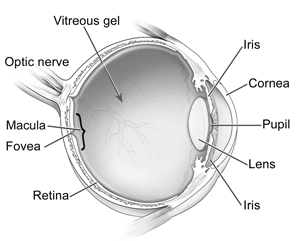Keratitis
What Is Keratitis?
Keratitis is an inflammation of the cornea, the clear, round dome that covers the iris, the colored portion of your eye, and the pupil, the black circle in the center of the iris. Keratitis is usually caused by the herpes simplex virus type 1, the same virus that causes cold sores. However, it can also be caused by the herpes zoster virus, the reactivation of the chicken pox virus in adults.
Other factors can cause keratitis including viruses that cause upper respiratory infections, and the same types of bacteria, fungus and virus that can cause corneal ulcers. Keratitis may also be caused by a deficiency of vitamin A, systemic rheumatoid disorders and any traumatic injury to the cornea.
Like the clear face of a watch protects its inner parts, the cornea provides a protective layer around the eye. It also helps focus light through the eye’s lens onto the retina, and plays an important role in our vision.
Photo Credit: National Eye Institute, National Institutes of Health
The inflammation associated with keratitis can damage the cornea and result in a loss of vision. In most cases, keratitis can be easily treated with prompt attention.
Keratitis usually causes pain and you may feel as if you have something in your eye. Your eye will be red and may tear. In addition, you may feel very sensitive to bright light, and your vision may be blurred. If keratitis is caused by the herpes simplex virus type 1, it will usually affect only one eye. With other causes, keratitis may impact both eyes.
Type 1 herpes is highly contagious. It is transmitted by skin contact with someone who has the virus. After your original infection, the virus can lay dormant for many years. Certain triggers such as stress, sun exposure, fever, trauma and certain medications can cause it to reactivate. By touching a cold sore or blister, you can transfer the virus to your eye. If your keratitis is caused by type 1 herpes simplex, the inflammation in your eye may be accompanied by small blisters on your eyelids.
Who Is at Risk for Keratitis?
Anyone who has ever had a cold sore is at risk of a reactivation of the virus. If you get another cold sore, you can transmit the virus to your eyes. Therefore, you should always take great care never to touch your eye after touching your cold sore.
Any injury or trauma to your eye, including surgery, can also put you at risk for developing keratitis.
How Is Keratitis Detected?
Your doctor will use a slit lamp examination to detect keratitis. He will first apply fluorescein drops to your eye which will highlight a tiny ulcer caused by a viral infection. Normally, infectious ulcers send out star-like branches that can be easily seen on the slit lamp.
If there is any doubt about the type of infection, he will apply numbing drops to your eye. Then, he will gently remove a small number of cells from the surface of your eye. These will be tested to confirm if it is a herpes simplex type of infection.
How Is Keratitis Treated?
If your keratitis is caused by the herpes simplex type 1 virus, it can easily be treated with antiviral eyedrops, topical acyclovir, ganciclovir gel, or oral antiviral medication. However, it’s important to remember that although the symptoms may subside, the virus can continue to remain dormant and could flare up at another time. In some severe cases, it may be necessary for your doctor to apply numbing eyedrops and gently scrape the affected areas of your cornea to remove damaged cells. If this is necessary, you will either wear an eye patch or use a special contact lens for a few days to allow the cornea to heal.
Since ocular herpes recurs in about 50 percent of patients, this can be a particular concern for people who wear contact lenses. If this is the case, we would recommend that you discontinue using contact lenses.
Anyone with a history of ocular herpes and keratitis should avoid using steroid eyedrops unless directed by your eye doctor. Steroids cause the virus to multiply and could accelerate vision problems in a recurrence.
If your keratitis is caused by either a bacterial or fungal infection, antibiotic or antifungal drops or medication may be used. In cases where dry eye causes keratitis, artificial tears may be used to lubricate your eyes. For other causes of keratitis, such as rheumatoid arthritis, treating the underlying illness and using artificial tears for lubrication are the treatments of choice. Incomplete blinking (from eyelid disorders or Bell's Palsy) can also cause Keratitis. Lubrication with artificial tears and ointments may be needed. Surgical treatment for certain lid mispositions is sometimes necessary.
Keratitis is a serious eye disorder that can result in scarring of your cornea and damage to your vision, if not treated. This is especially true if your keratitis is caused by the herpes simplex virus, since recurrence occurs in about half the patients. The key to preventing vision loss is to see your eye doctor at the first signs of symptoms.

